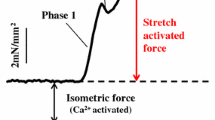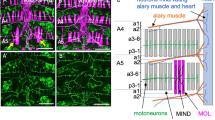Summary
The temperature-sensitive mutation shibire (shi) in Drosophila melanogaster is thought to disrupt membrane recycling processes, including endocytotic vesicle pinch-off. This mutation can perturb the development of nerves and muscles of the adult escape response. After exposure to a heat pulse (6 h at 30° C) at 20 h of pupal development, adults have abnormal flight muscles. Wing depressor muscles (DLM) are reduced in number from the normal six to one or two fibers, and are composed of enlarged fibers that appear to represent fiber fusion; large spaces devoid of muscle fibers suggested fiber deletion. The normal five motor axons are present in the peripheral nerve PDMN near the ganglion. However, while some motor axons pass dorsally to the extant fibers, other motor axons lacking end targets pass into an abnormal posterior branch and terminate in a neuroma, i.e., a tangle of axons and glia without muscle target tissue. Hemisynapses are common in axons of the proximal PDMN and within the neuroma, but they are rarely seen in control (no heat pulse) shi or wild-type flies. All surviving muscle fibers are innervated; no muscle tissue exists without innervation. Fibrillar fine structure and neuromuscular synapses appear normal. Fused fibers have dual innervation, suggesting correct and specific matching of target tissue and motor axons. Motor axons lacking target fibers do not innervate erroneous targets but instead terminate in the neuroma. These results suggest developmental constraints and rules, which may contribute to the orderly, stereotyped development in the normal flight system. The nature of the anomalies inducible in the flight motor system in shi flies implies that membrane recycling events at about 20 h of pupal development are critical to the formation of the normal adult nerve-muscle pattern for DLM flight muscles.
Similar content being viewed by others
References
Anderson H (1985) The development of projections and connections from transplanted locust sensory neurons. J Embryol Exp Morphol 85:207–224
Arbas EA, Tolbert LP (1986) Presynaptic terminals persist following degeneration of “flight” muscle during development of a flightless grasshopper. J Neurobiol 17:627–636
Bastiani MJ, Goodman CS (1984) Neuronal growth cones: Specific interactions mediated by filopodial insertion and induction of coated vesicles. Proc Natl Acad Sci USA 81:1849–1853
Bastiani MJ, Doe CQ, Helfand SL, Goodman CS (1985) Neuronal specificity and growth cone guidance in grasshopper and Drosophila embryos. Trends Neurosci 8:257–266
Bastiani MJ, Harrelson AL, Snow PM, Goodman CS (1987) Expression of fasciclin I and II glycoproteins on subsets of axon pathways during neuronal development in the grasshopper. Cell 48:745–755
Bentley D, Caudy M (1983) Pioneer axons lose directed growth after selective killing of guidepost cells. Nature 304:62–65
Bentley D, Keshishian H (1982) Pioneer neurons and pathways in insect appendages. Trends Neurosci 5:354–358
Berlot J, Goodman CS (1984) Guidance of peripheral pioneer neurons in the grasshopper: Adhesive hierarchy of epithelial and neuronal surfaces. Science 223:493–496
Bodenstein D (1950) The postembryonic development of Drosophila. In: Demerec M (ed) The Biology of Drosophila. Wiley, New York, pp 275–367
Coggshall JC (1978) Neurons associated with the dorsal longitudinal flight muscles of Drosophila melanogaster. J Comp Neurol 177:707–720
Costello WJ (1986) Formation of adult motor systems in Drosophila: Scanning electron microscope study. Neuroscience (Abstr) 12:930
Costello WJ, Hummon MR (1985) Development of giant fiber pathway components in Drosophila: possible involvement of coated vesicles. Neuroscience (Abstr) 11:918
Costello WJ, Salkoff L (1983) Induced reduction in fiber number of indirect flight muscles in the Drosophila mutant shibire. Neuroscience (Abstr) 9:832
Costello WJ, Salkoff LB (1986) Suppression of the membrane defect by divalent cations in the Drosophila mutant shibire. J Neurosci 6:3634–3639
Costello WJ, Wyman RJ (1986) Development of an indirect flight muscle in a muscle-specific mutant of Drosophila melanogaster. Dev Biol 118:247–258
Crossley AC (1978) The morphology and development of the Drosophila muscular system. In: Ashburner M, Wright TRF (eds) The genetics and biology of Drosophila, vol 2b. Academic Press, New York, pp 499–560
Deak II, Rahmi A, Bellamy PR, Bienz M, Blumer A, Fenner E, Gollin M, Ramp T, Reinhardt C, Dubendorfer A, Cotton B (1980) Developmental and genetic studies of the indirect flight muscles of Drosophila melanogaster. In: Siddiqui O, Babu P, Hall LM, Hall JC (eds) Development and neurobiology of Drosophila. Plenum, New York, pp 183–192
Denburg JL, Seecof RL, Horridge GA (1977) The path and rate of growth of regenerating motor neurons in the cockroach. Brain Res 125:213–226
Denburg JL, Caldwell RT, Marner JM (1987) Differences in surface molecules of motor axon terminals correlated with cell-cell recognition. J Neurobiol 18:407–416
Elder HY (1975) Muscle structure. In: Usherwood PNR (ed) Insect muscle. Academic Press, New York, pp 1–74
Finlayson LH (1975) Development and degeneration. In: Usherwood PNR (ed) Insect muscle. Academic Press, New York, pp 75–149
Grigliatti TA, Hall L, Rosenbluth R, Suzuki DT (1973) Temperature-sensitive mutations in Drosophila melanogaster. XIV. A selection of immobile adults. Mol Gen Genet 120:107–114
Harcombe ES, Wyman RJ (1977) Output pattern generation by Drosophila flight motoneurons. J Neurophysiol 40:1066–1077
Harcombe ES, Wyman RJ (1978) The cyclically repetitive firing sequences of identified Drosophila flight motoneurons. J Comp Physiol 123:271–279
Hirano A, Shin W-Y (1979) Unattached presynaptic terminals in a cerebellar neuroblastoma in the human. Neuropathol Appl Neurobiol 5:63–70
Hummon MR, Costello WJ (1984) Induced alteration in the development of the Drosophila giant fiber pathway in the temperature-sensitive mutant shibire. Neuroscience (Abstr) 10:1032
Hummon MR, Costello WJ (1986) Induction of neuroma formation and specific target muscle deletion in the Drosophila ts mutant shibire. Neuroscience (Abstr) 12:929
Hummon MR, Costello WJ (1987a) Fate of motor axons lacking target muscles in the Drosophila ts mutant shibire. Neuroscience (Abstr) 13:593
Hummon MR, Costello WJ (1987b) Induced disruption in the connectivity of an identified neuron in the Drosophila ts mutant shibire. J Neurosci 8:3633–3638
Hummon MR, Costello WJ (1987c) Alteration of abdominal segmentation and muscle in Drosophila, ts shibire. Am Zool (Abstr) 27:144A
Ikeda K, Koenig JH, Tsuruhara T (1980) Organization of identified axons innervating the dorsal longitudinal flight muscle of Drosophila melanogaster. J Neurocytol 9:799–823
Kim Y-T, Wu C-F (1987) Reversible blockage of neurite development and growth cone formation in neuronal cultures of a temperature-sensitive mutant of Drosophila. J Neurosci 7:3245–3255
King DG, Wyman RJ (1980) Anatomy of the giant fibre pathway in Drosophila. I. Three thoracic components of the pathway. J Neurocytol 9:753–770
King DG, Kammlade N, Murphy J (1982) A simple device to help re-embed thick plastic sections. Stain Tech 57:307–310
Koenig JH, Ikeda K (1980a) Neural interactions controlling timing of flight muscle activity in Drosophila. J Exp Biol 87:121–136
Koenig JN, Ikeda K (1980 b) Interspike interval relationship among flight muscle fibers in Drosophila. J Exp Biol 87:137–147
Koenig JH, Ikeda K (1983) Evidence for a presynaptic blockage of transmission in a temperature-sensitive mutant of Drosophila. J Neurobiol 14:411–419
Koenig JH, Saito K, Ikeda K (1983) Reversible control of synaptic transmission in a single gene mutant of Drosophila melanogaster. J Cell Biol 96:1517–1522
Kosaka T, Ikeda K (1983a) Possible temperature-dependent blockage of synaptic vesicle recycling induced by a single gene mutation in Drosophila. J Neurobiol 14:207–225
Kosaka T, Ikeda K (1983b) Reversible blockage of membrane retrieval and endocytosis in the garland cell of the temperature-sensitive mutant of Drosophila melanogaster, shibire ts1. J Cell Biol 97:499–507
Lawrence PA, Brower DL (1982) Myoblasts from Drosophila wing disks can contribute to developing muscles throughout the fly. Nature 295:55–57
Marx JL (1987) Oncgene linked to fruit-fly development. Science 238:160–161
McAllister L, Zinn K, Snow PM, Elkins T, Schilling J, Makk G, Goodman CS (1987) Molecular genetic analysis of fasciclin I from grasshopper and Drosophila: Sequences of cDNA clones encoding multiple forms of the protein. Neuroscience (Abstr) 13:1222
Miller A (1950) The internal anatomy and histology of the imago of Drosophila melanogaster. In: Demerec M (ed) Biology of Drosophila. Hafner, New York, pp 420–534
Nassel DR, Helgee A, Sivasubramanian P (1986) Development of axon paths of motoneurons after removal of target muscles in a holometabolous insect. Dev Brain Res 26:211–219
Patel NH, Snow PM, Goodman CS (1987) Characterization and cloning of fasciclin III: A glycoprotein expressed on a subset of neurons and axon pathways in Drosophila. Cell 48:975–988
Poodry CA, Edgar L (1979) Reversible alterations in the neuromuscular junctions of Drosophila melanogaster bearing a temperature-sensitive mutation, shibire. J Cell Biol 81:520–527
Poodry CA, Hall L, Suzuki DT (1973) Developmental properties of shibirets1: A pleiotropic mutation affecting larval and adult locomotion and development. Dev Biol 32:373–386
Raper JA, Bastiani MJ, Goodman CS (1984) Pathfinding by neuronal growth cones in grasshopper embryos. IV. The effects of ablating the A and P axons upon the behavior of the G growth cone. J Neurosci 4:2329–2345
Rheuben MB, Kammer AE (1980) Comparison of slow larval and fast adult muscle innervated by the same motor neurone. J Exp Biol 84:103–118
Salkoff L (1985) Development of ion channels in the flight muscles of Drosophila. J Physiol (Paris) 80:275–282
Salkoff L, Kelly L (1978) Temperature-induced seizure and frequency-dependent neuromuscular block in a ts mutant of Drosophila. Nature 273:156–158
Shatoury HH (1956) Developmental interactions in the development of the imaginal muscles of Drosophila. J Embryol Exp Morphol 4:228–239
Whitington PM (1985) Functional connections with foreign muscles made by a target-deprived insect motoneuron. Dev Biol 107:537–540
Whitington PM, Bate M, Seifert E, Ridge K, Goodman CS (1982) Survival and differentiation of identified embryonic neurons in the absence of their target muscles. Science 215:973–975
Author information
Authors and Affiliations
Rights and permissions
About this article
Cite this article
Hummon, M.R., Costello, W.J. Induced neuroma formation and target muscle perturbation in the giant fiber pathway of the Drosophila temperature-sensitive mutant shibire . Roux's Arch Dev Biol 197, 383–393 (1988). https://doi.org/10.1007/BF00398989
Received:
Accepted:
Issue Date:
DOI: https://doi.org/10.1007/BF00398989




